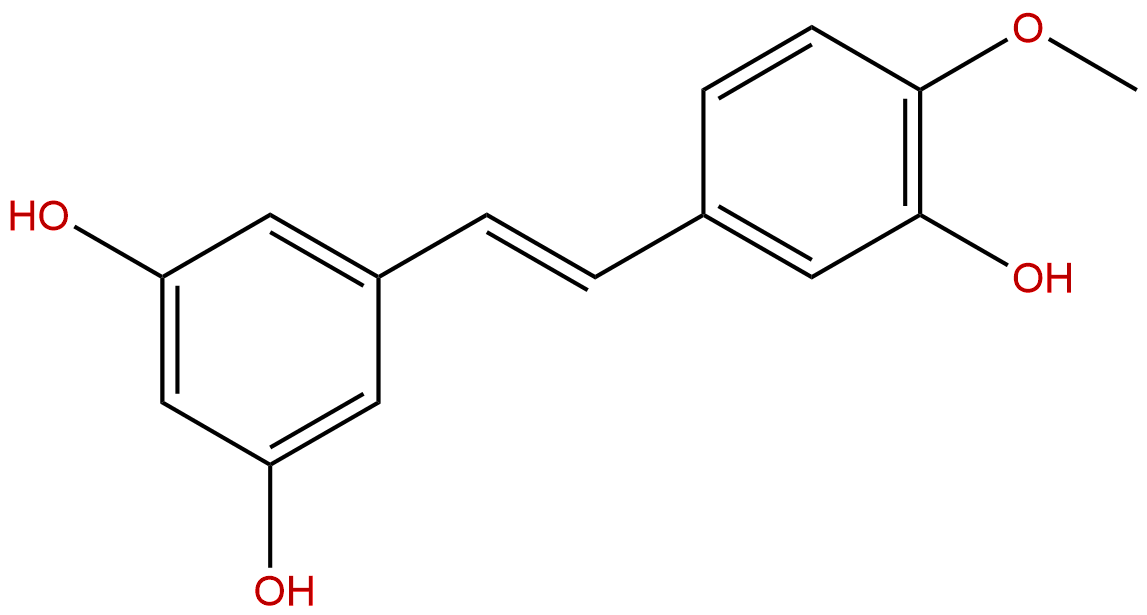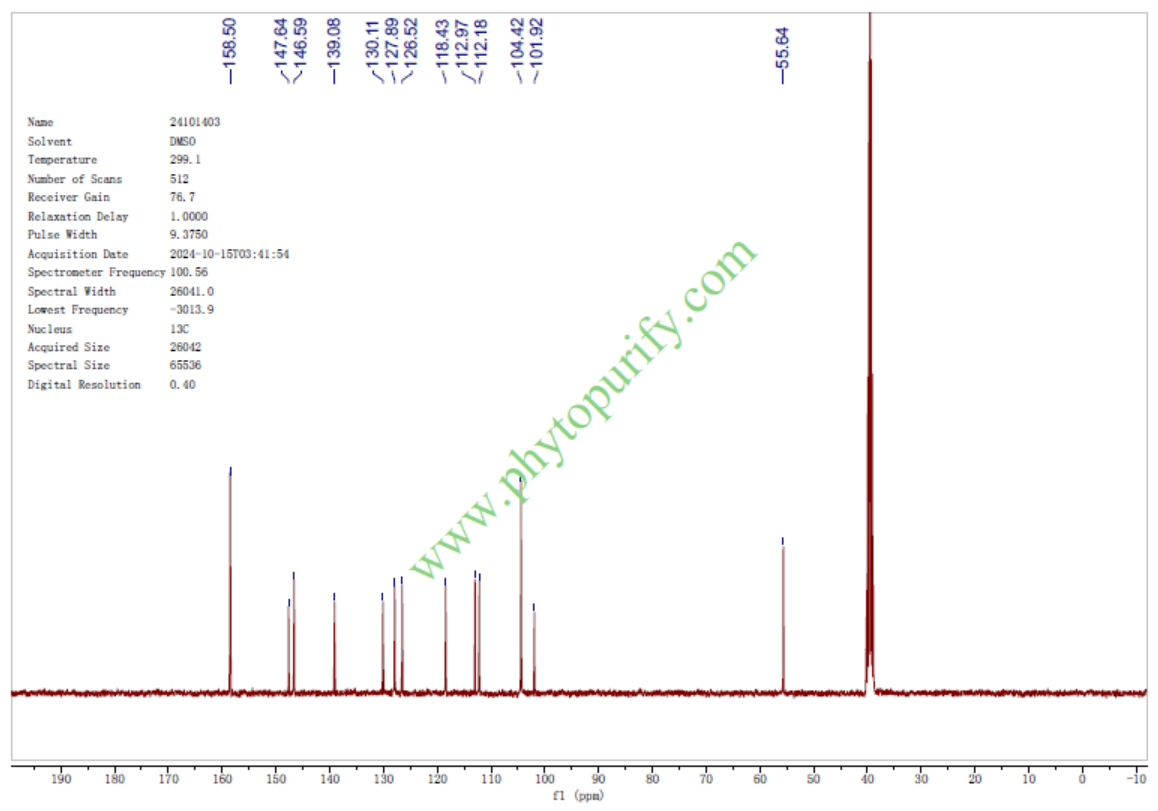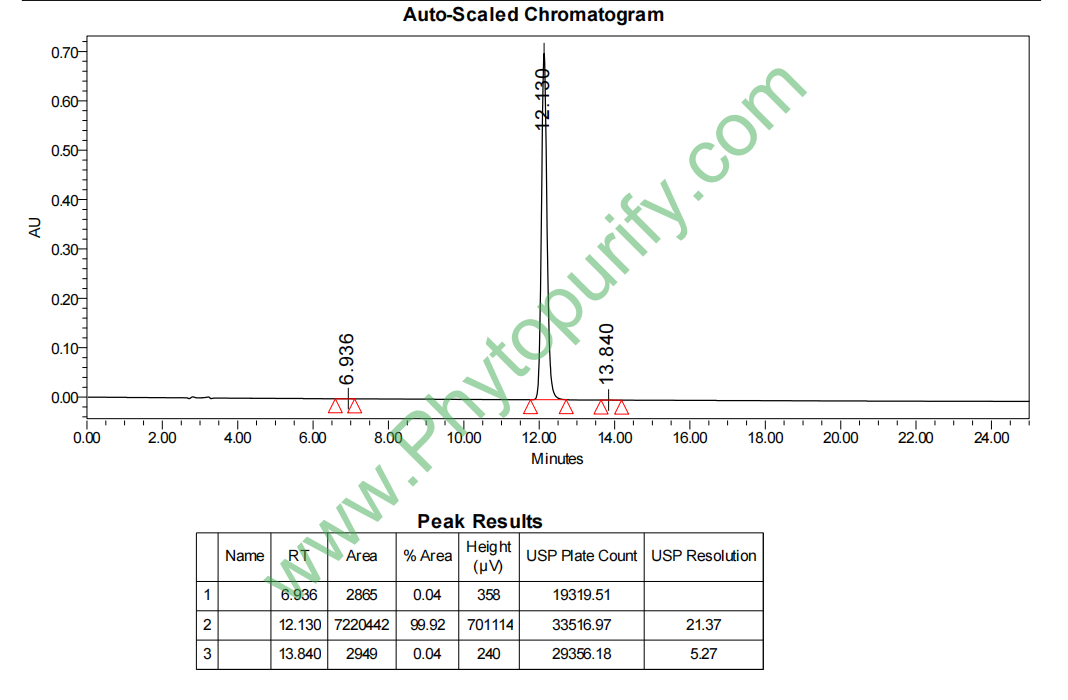
RhapontigeninCAS No.:500-65-2
|
||||||||||
 |
|
|
||||||||

| Catalogue No.: | BP1671 |
| Formula: | C15H14O4 |
| Mol Weight: | 258.273 |
Product name: Rhapontigenin
Synonym name:
Catalogue No.: BP1671
Cas No.: 500-65-2
Formula: C15H14O4
Mol Weight: 258.273
Botanical Source:
Physical Description: Cryst.
Type of Compound: Phenols
Purity: 95%~99%
Analysis Method: HPLC-DAD or/and HPLC-ELSD
Identification Method: Mass, NMR
Packing: Brown vial or HDPE plastic bottle
The product could be supplied from milligrams to grams. Inquire for bulk scale.
We provide solution to improve the water-solubility of compounds, thereby facilitating the variety of activity tests and clinic uses.
For Reference Standard and R&D, Not for Human Use Directly.
Description:
Rhapontigenin has antioxidative, antihyperlipidemic, antifungal and anticancer activities. Rhapontigenin inhibits HIF-1α accumulation and angiogenesis in PC-3 prostate cancer cells, suppresses breast cancer cell migration and invasion, which is involved in inhibiting the PI3K-dependent Rac1 signaling pathway. Rhapontigenin exhibits dose-dependent inhibition of tyrosinase activity and melanin synthesis in B16F10 melanoma cells.
References:
Antihyperlipidemic effects of rhapontin and rhapontigenin from rheum undulatum in rats fed a high-cholesterol diet.
Rhapontin was purified from a methanol extract from the roots of Rheum undulatum, and Rhapontigenin was produced by an enzymatic transformation of rhapontin. Rats were fed a high-cholesterol diet to induce hyperlipidemia, followed by oral treatment with rhapontin or Rhapontigenin (1-5 mg/kg/day). Rhapontin and Rhapontigenin treatment resulted in a significant (p<0.05) dose-dependent decrease in the serum lipid level, while the high-density lipoprotein cholesterol level increased slightly compared with the experimental control. Furthermore, rhapontin and Rhapontigenin treatment improved the pathological characteristics of the degenerating fatty liver in high-cholesterol diet-induced hyperlipidemic rats dose-dependently. Aspartate aminotransferase and alanine aminotransferase levels in rhapontin- and Rhapontigenin-treated hyperlipidemic rats were not significantly different from those in the control. These results indicate that rhapontin and Rhapontigenin can be used as potent antihyperlipidemic agents.
The possible mechanism of rhapontigenin influencing antifungal activity on Candida albicans.
Rhapontigenin, an aglycone of rhapontin, was produced by biotransformation and we investigated its antifungal activity against Candida albicans, one of the most important opportunistic fungal pathogens. Rhapontigenin is found to have, in vitro, inhibitory activity with a minimal inhibitory concentration (MIC) value against all test isolates of 128-256 μg/ml. We detected increased reactive oxygen species (ROS) levels in yeast cultures treated with Rhapontigenin at the MIC. Rhapontigenin inhibited DNA, RNA, and protein synthesis, especially RNA synthesis, and induced morphological changes and apoptosis of C. albicans. The apoptotic effect of Rhapontigenin on C. albicans at subinhibitory concentrations was higher in the stationary growth phase than in the exponential phase, while the opposite results were noted with amphotericin B. The mechanism of antifungal activity of Rhapontigenin may be associated with the generation of ROS that might induce apoptosis and it may also involve the inhibition of ergosterol biosynthesis.
Rhapontigenin suppresses cell migration and invasion by inhibiting the PI3K-dependent Rac1 signaling pathway in MDA-MB-231 human breast cancer cells.
Rhapontigenin (1) has various biological activities including anticancer activities. However, whether and how Rhapontigenin affects cancer invasion has never been explored. Here, we examined the anti-invasive effects of Rhapontigenin and its underlying molecular mechanisms in the highly invasive human breast cancer cell line designated MDA-MB-231. At noncytotoxic concentrations, Rhapontigenin strongly suppressed serum-induced cell migration and invasion as judged by Boyden chamber analysis and wound-healing assays, respectively. Rhapontigenin strikingly reduced Rac1 activity as judged by both absorbance-based and pull-down assays. In addition, its downstream effectors such as WASP-family verprolin homologous proteins 2 (WAVE-2) and p21-activated kinase Rhapontigenin (PAK1) signaling cascades were attenuated after treatment with Rhapontigenin. Immunofluorescence staining showed that Rhapontigenin diminished lamellipodia formation at the leading edge of cells. Finally, Rhapontigenin decreased the phosphorylation of phosphoinisitide-3-kinase (PI3K) and AKT. Rac1 activity was inhibited by the PI3K inhibitor wortmannin. Taken together, these results suggest that Rhapontigenin suppresses breast cancer cell migration and invasion, which is involved in inhibiting the PI3K-dependent Rac1 signaling pathway.
Rhapontigenin converted from rhapontin purified from Rheum undulatum enhances the inhibition of melanin synthesis.
Rhapontigenin was produced from rhapontin isolated from a methanol extract of Rheum undulatum roots by enzymatic transformation. Rhapontin and Rhapontigenin exhibited dose-dependent inhibition of tyrosinase activity and melanin synthesis in B16F10 melanoma cells, but the inhibitory activity of Rhapontigenin was greater than that of rhapontin. Thus the bioconversion of rhapontin enhanced its ability to inhibit cellular tyrosinase activity and melanin synthesis.
Rhapontigenin inhibited hypoxia inducible factor 1 alpha accumulation and angiogenesis in hypoxic PC-3 prostate cancer cells.
The inhibitory mechanism of Rhapontigenin isolated from Vitis coignetiae was investigated on HIF-1α stability and angiogenesis in human prostate cancer PC-3 cells. Rhapontigeninsignificantly suppressed HIF-1α accumulation at protein level but not at mRNA level in PC-3 cells under hypoxia. Also, Rhapontigenin suppressed hypoxia-induced HIF-1α activation in various cancer cells, such as colorectal adenocarcinoma (SW620), breast adenocarcinoma (MCF-7), fibrosarcoma (HT-1080) and prostate carcinoma (LNCaP). Interestingly, Rhapontigenin had more potency in inhibition of hypoxia-induced HIF-1α expression than that of resveratrol, a known HIF-1α inhibitor. In addition, Rhapontigenin promoted hypoxia-induced HIF-1α degradation and cycloheximide (CHX) blocked protein synthesis. A prolyl hydroxylase (PHD) inhibitor dimethyloxalylglycine (DMOG) is usually utilized to examine whether prolyl hydroxylation is involved in inhibition of HIF-1α accumulation. Here, DMOG recovered HIF-1α accumulation inhibited by Rhapontigenin. Immunoprecipitation assay also revealed that rhapotigenin enhanced the binding of hydroxylated HIF-1α to von Hippel-Lindau (VHL) tumor suppressor protein. Furthermore, Rhapontigenin reduced vascular endothelial growth factor (VEGF) secretion in hypoxic PC-3 cells as well as suppressed tube formation in human umbilical vein endothelial cells (HUVECs) treated by the conditioned media of hypoxic PC-3 cells. However, anti-angiogenic effect of Rhapontigenin in hypoxic PC-3 cells was reversed by DMOG. Taken together, these findings suggest that Rhapontigenin inhibits HIF-1α accumulation and angiogenesis in PC-3 prostate cancer cells.
NMR of Rhapontigenin

HPLC of Rhapontigenin
